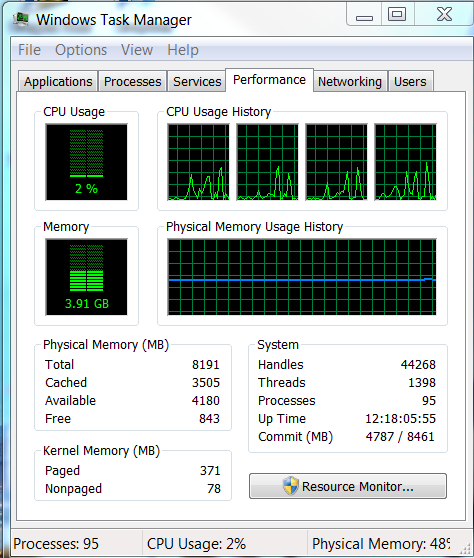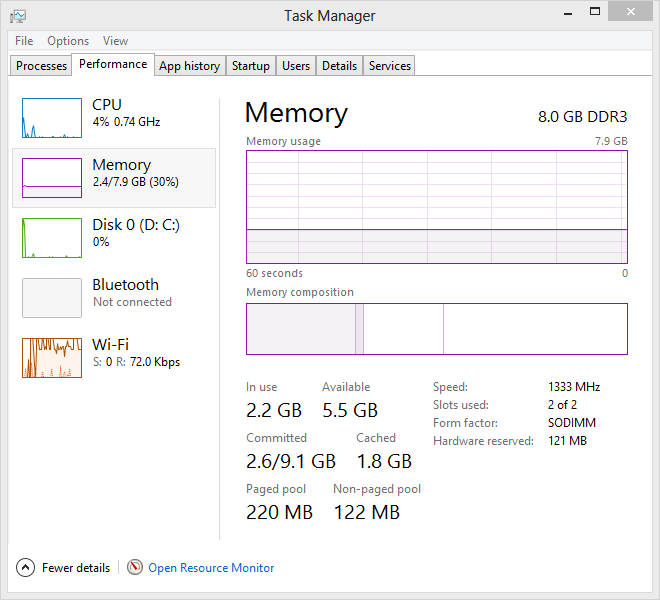-
-
products
-
resources
-
support
-
company
-
What is the difference between available and free physical memory?
By Davide De Vellis November 28, 2013computer performance, memory, slow pc, upgrade, windows, Windows 7, windows 8, windows vista, Windows XP2 CommentsWhen your computer starts slowing down, there could be any number of reasons for this happening, and with a bit of troubleshooting you can often determine the culprit. We offer a number of free resources within the ReviverSoft Blog if you want to do it yourself and we also have a number of products on our website that will do a lot of the work for you. Working through this troubleshooting process can tell you whether you can solve the problem with some maintenance and optimization, get by with an inexpensive upgrade, or if it’s time to invest in a whole new computer system.
An often misunderstood concept is how much memory you have on your system and how this can affect your computer’s performance. To find out, your task manager is a good place to start. Among other things, it lists your memory and processor usage. As these values start approaching 100 percent, your system will slow down or stop working. Unfortunately, the messages that Windows gives can be somewhat cryptic. With so many options, let’s find out how much memory you are really using.

“Press “Ctrl”+”Alt”+”Del” to access the Task Manager to check various system vitals, including memory useage”By breaking down the different options it can be much easier to understand what is going on.
Total Memory.This is how much is installed in your computer. Nowadays, memory is sold in gigabytes (GB) and if your screen shows megabytes (MB) use the numbers in the thousands column to see how much you have. If you need to buy memory this is one of the most important numbers to have on hand.
Cached.This is where things can become confusing. The objective of memory is to make things accessible more quickly. To this end, Windows loads items into memory that aren’t needed yet, but might be later. This is cached memory. It has stuff in it, but it can be emptied if it is needed by one of your programs.
Free.This is memory that is actually empty. As you would imagine, this space is available for use, either as additional cache or straight into a program. Don’t worry if this number is smaller than you expect. It is not all the memory that you actually have available to run programs.
Available.This is the number you are looking for. If this goes to zero your system will be very unhappy. With closer inspection, you should see that this number is equal to cached memory plus free memory (minus a little bit). This is because not all the cached memory can be dumped (or freed up) instantly. It is likely that at least a little bit of it will actually be called into action.
Commit/Page File.Windows actually uses a little bit of your hard drive to help manage your memory better. It places items that aren’t needed right away here so that active items can use the faster, physical memory. Programs will often ask for large chunks of committed memory, even if they won’t actually use it, so this is not something to be concerned about.

“Widows 8 Task Manager has similar information about system memory”Now that you know what each of these numbers mean, you can quickly see where your system is at with respect to memory and usage. If you are running a lot of programs, you can always close a few to easily use less memory. On the other hand, if running even the simplest of programs take up almost all of your resources, it might well be time to check into a memory upgrade or even a whole new system.
Was this post helpful?YesNoFree Driver Updates
Update your drivers in less than 2 minutes to enjoy better PC performance - Free.
Free Driver Updates
Update your drivers in less than 2 minutes to enjoy better
PC performance - Free.
Didn't find your answer?Ask a question to our community of experts from around the world and receive an answer in no time at all.most relevant recent articles Pin It on Pinterest